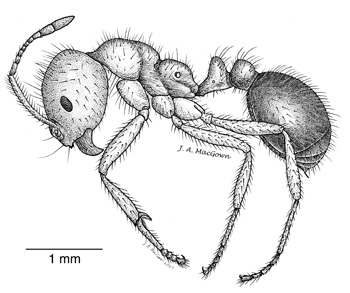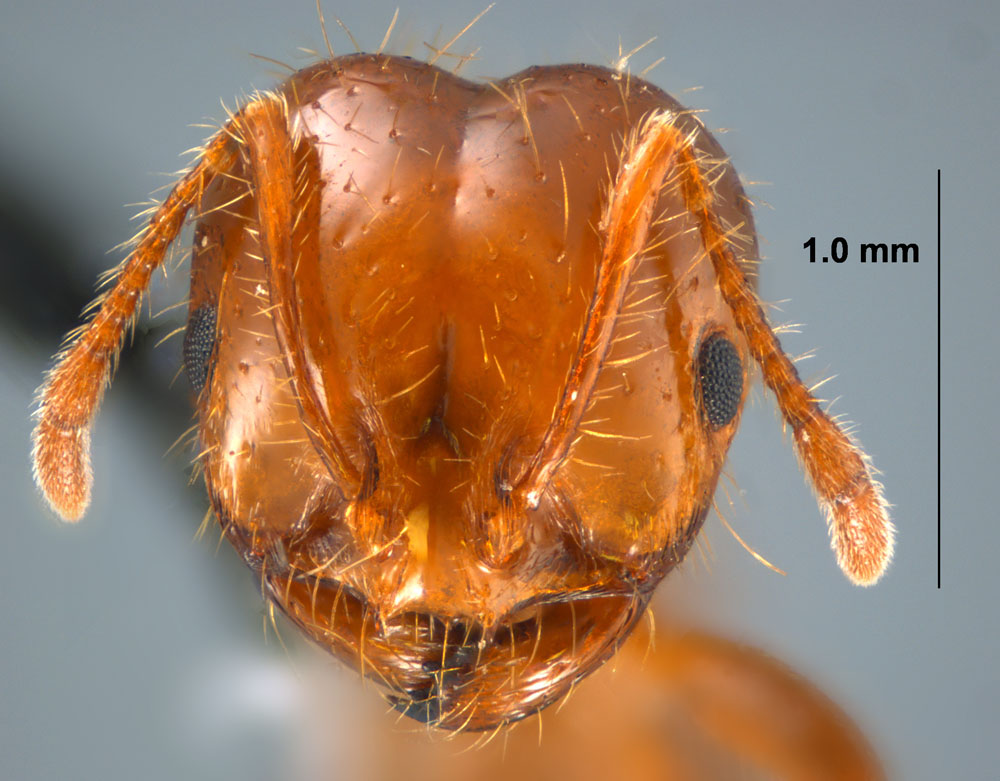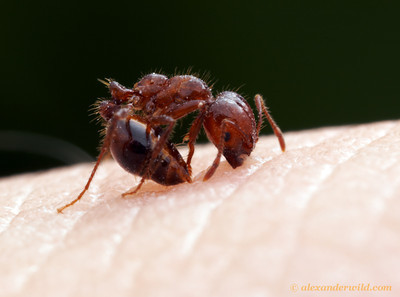Adaptation
Solenopsis invicta have developed many characteristics over
time that have helped them to overcome the hurdles they face in
their daily lives. Complications such as
 weather changes,
predation, and competition leave a great impact on the life of
the RIFA which is why they have developed adaptations over time
to better help them survive. In general, the ants that are
designated “workers” range from 1/16th to 1/5th inches long.
What distinguishes these ants from others is their reddish body
color along with the dark brown gaster (the last abdominal
segment) and, of course, the stinger. They have large eyes and
three teeth on the front of their head. Other morphological
characteristics include ten segmented antennae, a petiole (which
is the section adjacent to the gaster) with two nodes, and an
absence of spines on the thorax (Greenberg et al. 2012).
weather changes,
predation, and competition leave a great impact on the life of
the RIFA which is why they have developed adaptations over time
to better help them survive. In general, the ants that are
designated “workers” range from 1/16th to 1/5th inches long.
What distinguishes these ants from others is their reddish body
color along with the dark brown gaster (the last abdominal
segment) and, of course, the stinger. They have large eyes and
three teeth on the front of their head. Other morphological
characteristics include ten segmented antennae, a petiole (which
is the section adjacent to the gaster) with two nodes, and an
absence of spines on the thorax (Greenberg et al. 2012).
It has been
found that the antenna of this species of ant contains
chemosensory proteins which are thought to be involved in
chemical signaling transmitted by the ants. One particular
chemosensory protein is conveyed in the worker antennae and has
led biologists to believe that there is an underlying olfa ctory
function (Gonzalez et al. 2009). S. invicta have antenna that
are ten-segmented, with two-segmented clubs at each end. The Red
Imported Fire Ants depend on communication between one another,
and the antenna is a key channel of sensory input they use. Each
antennae possess receptors for “volatile odors and pheromones,
contact chemoreception, water vapor, carbon dioxide, sound,
proprioception, and touch” (Renthal et al. 2003). Biologists have
also discovered that the antennae are “sexually dimorphic,”
meaning that the male and female antennae vary due to their
differing roles in a colony. The male antenna are relatively
simple due to the fact that the male ants do not participate in
foraging or take care of the brood like the females.
ctory
function (Gonzalez et al. 2009). S. invicta have antenna that
are ten-segmented, with two-segmented clubs at each end. The Red
Imported Fire Ants depend on communication between one another,
and the antenna is a key channel of sensory input they use. Each
antennae possess receptors for “volatile odors and pheromones,
contact chemoreception, water vapor, carbon dioxide, sound,
proprioception, and touch” (Renthal et al. 2003). Biologists have
also discovered that the antennae are “sexually dimorphic,”
meaning that the male and female antennae vary due to their
differing roles in a colony. The male antenna are relatively
simple due to the fact that the male ants do not participate in
foraging or take care of the brood like the females.
Furthermore,
the morphological feeding structures of the adult ants have been
especially advantageous in their mission of finding and
consuming the proper nutrition needed for them to survive. S.
invicta have chewing mouth parts with mandibles that are adapted
to bite, slice, and rip solid food apart and, alternatively, aid
in nest maintenance, defense, and construction. Their mouthparts
also possess a pre-oral cavity that is used as a “food receiving
pocket.” Added to that, the ants also grow ridges and hairs
along the mouth cavity in order to sift out particles and
debris from the liquids they consume. The particles are
compacted into pellets that later can be discarded (Klotz et
al. 2008).
One of their
most well-known adaptations, however, is their venomous sting
that many humans have had the displeasure of experiencing on a
first hand basis. Th e
Red Imported Fire Ants are at risk for
predation due to their relatively small size compared to the
other organisms they encounter. As a solution to this problem,
the RIFA inject a “necrotizing, alkaloid venom” into those who
threaten them. Most of the venom is composed of these alkaloids,
which are the cause of not only the pain, but also the white
abscess that one can expect to see approximately a day after the
stinging incident. The rest of the venom is made up of a mixture of proteins and other small molecules that can produce an
allergic reaction in hypersensitive individuals. When a fire ant
mound is disturbed, for example with a shoe, many ants will rush
out of the nest and crawl up the shoe very quickly stinging the
intruder. This is accomplished when the worker ants attach to
their victims with their mandibles and then lower the tip of
their gaster in order to inject the venom through the stinger
and into their target. This particular species of ants not only
bites but stings as well (Collins and Scheffrahn 2001).
e
Red Imported Fire Ants are at risk for
predation due to their relatively small size compared to the
other organisms they encounter. As a solution to this problem,
the RIFA inject a “necrotizing, alkaloid venom” into those who
threaten them. Most of the venom is composed of these alkaloids,
which are the cause of not only the pain, but also the white
abscess that one can expect to see approximately a day after the
stinging incident. The rest of the venom is made up of a mixture of proteins and other small molecules that can produce an
allergic reaction in hypersensitive individuals. When a fire ant
mound is disturbed, for example with a shoe, many ants will rush
out of the nest and crawl up the shoe very quickly stinging the
intruder. This is accomplished when the worker ants attach to
their victims with their mandibles and then lower the tip of
their gaster in order to inject the venom through the stinger
and into their target. This particular species of ants not only
bites but stings as well (Collins and Scheffrahn 2001).
Other
fascinating characteristics of the RIFA include the way in which
they reproduce along with their life cycle. You can learn more
specifics regarding the reproduction of the Red Imported Fire
Ant by clicking here.
Click here to return to the home page.
